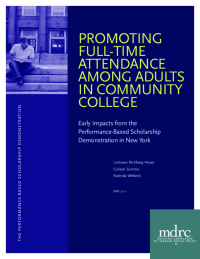Promoting Full-Time Attendance Among Adults in Community College
Early Impacts from the Performance-Based Scholarship Demonstration in New York
Many adult students struggle to finance their educations, often contending with work and child care expenses in addition to the extra cost of remedial courses. Moreover, there is little need-based grant aid to help. This report presents early findings from an evaluation of a program in New York City targeted to low-income adults (ages 22 to 35) who need remedial course work. Part of MDRC’s national Performance-Based Scholarship (PBS) Demonstration, the program operated at Borough of Manhattan Community College and Hostos Community College, both part of the City University of New York, in 2008 and 2009. Participating students were eligible for either a $1,300 scholarship for two consecutive semesters (totaling up to $2,600) or for $1,300 for each of those semesters and one summer term (totaling up to $3,900), if they maintained at least part-time enrollment, met attendance benchmarks, and earned at least a “C” average across six credits of courses. Scholarships were paid directly to students in increments and did not supplant other aid for which students qualified.
This innovative program, along with those in five other states in the PBS Demonstration, builds on lessons from MDRC’s Opening Doors Demonstration in Louisiana, which led to higher rates of persistence and credit accumulation. The Louisiana program offered performance-based scholarships to low-income parents for two semesters; counselors met with students periodically and disbursed the scholarships. Unlike the Louisiana program, the New York PBS program did not include counseling and focused on adult students needing remediation.
The PBS evaluation randomly assigned approximately 1,500 low-income students to one of two program groups eligible to receive up to either $2,600 or $3,900 in scholarships, or to a control group eligible only for usual financial aid. Comparing outcomes of the combined program groups with control group outcomes measures the impact of the scholarship program. Comparing outcomes for the two program groups speaks to the relative importance of additional funding for summer attendance. Early analyses of student transcripts for about 60 percent of the total sample suggest that the program:
- Encouraged more full-time enrollment. Even though the scholarship required only part-time attendance, full-time enrollment increased 5.6 percentage points (7.9 percent) in the first semester and 7.4 percentage points (14 percent) in the second semester. Students may have used the funds to purchase more education.
- Resulted in more students eligible for summer funding registering for summer courses. Summer funding increased summer attendance by 7.8 percentage points — about a 40 percent increase over the usual 20 percent of students in such courses.
These findings suggest that incentive scholarships may increase full-time attendance and summer enrollment, which may, in turn, benefit low-income adults needing remediation by decreasing the time they need to earn degrees or certificates. Future reports will present impacts for the full sample on measures not covered here, including student retention, credit accumulation, graduation and transfer rates, motivation, and use of scholarship monies.






